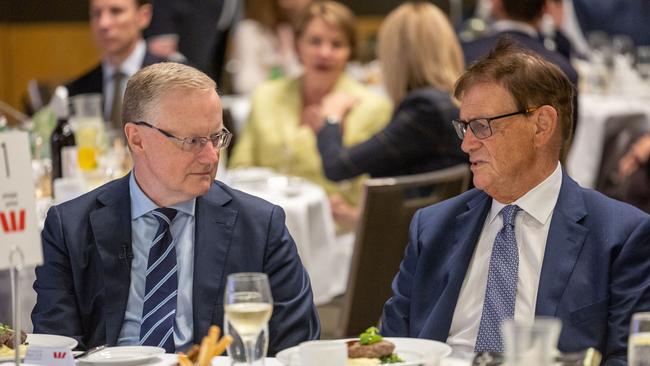RBA governor Philip Lowe faces lineball call on interest rates; ASX 200 set to start week 1pc higher
Philip Lowe has to weigh up higher-than-expected inflation with a cooling economy economists say as the RBA is set to determine the next interest rate move on Tuesday.
Australia’s sharemarket is expected to start the week firmly higher as the Reserve Bank faces a lineball decision on whether to raise interest rates for the twelfth time since last April.
ASX SPI 200 futures are pointing to a 1.1 per cent gain to 7229 on Monday.
The lift in futures markets, following a similar rise on Wall Street, is at odds with expectations of an interest rate hike, given the sharemarket typically falls when the RBA tightens, with bonds becoming a more attractive investment option.
The likelihood of another interest rate hike has swung wildly in the past week after the Fairwork Commission approved a 5.75 per cent increase in award wages, covering 2.5 million workers.
It also granted a hike of 8.6 per cent to the 184,000 employees on the minimum wage. The commission’s moves have sparked fears that companies will lift prices further, forcing the RBA to hike interest rates even more to tame stubborn inflation, which rose higher than expected in the year to April.
Money markets were last pricing a 36.3 per cent chance of another interest rate hike on Tuesday.
Of 25 economists surveyed by Bloomberg, eight are forecasting another 25 bps hike, which would lift the cash rate to 4.1 per cent.
AMP Capital chief economist Shane Oliver is one of those economists but says the RBA will also have to temper its decision with other data showing the economy is cooling, with retail sales, building approvals and growth in business investment weaker.

“Sure, the economy is probably still growing but as we saw in the late 1980s tightening episode the economy was okay till it wasn’t,” Dr Oliver said.
“Key risks on this front are that a 4 per cent plus cash rate will push debt servicing costs into record territory as a share of household income and on the RBA’s analysis 15 per cent of households with a variable rate mortgage — which means about 1 million people — will be cash flow negative by year end at 3.75 per cent cash rate and we are now going well beyond this.
“So following the April inflation data and the further step in minimum and award wages growth, the risk is now very high that ongoing inflation and wages concerns will see the RBA over-tighten and knock the economy off the ‘narrow path’ — between tightening too little and tightening too much that governor (Philip) Lowe has been referring to — into recession.”
Dr Oliver expects inflation will “slow rapidly” as the economy cools. “But it’s looking increasingly doubtful that it will come quickly enough for the RBA as it will have moved rates up again before it arrives.”
NAB economist Taylor Nugent also is expecting another hike. “NAB’s call has been for the cash rate to reach 4.1 per cent by August, with July most likely and the risks skewed to a higher peak. The risk now is the RBA moves in June and may deem it necessary to take the cash rate beyond 4.35 per cent,” Mr Nugent said.
But Westpac chief economist Bill Evans said the RBA will most likely keep rates on hold at 3.85 per cent, while “continuing to emphasise its tightening bias”. He expected the RBA to wait to assess Australia’s national accounts for the March quarter, which will be released on Wednesday, to gauge how the economy is performing before deciding on any rate movements.
“With (RBA) board meetings every month and given the rapid increase in rates since May last year waiting for the national accounts report seems to be the most prudent approach,” Mr Evans said.
“This report will also provide important updates on other areas of concern for the board, including the savings rate; productivity; labour costs and inflation.
“Overall we are expecting consumer spending to be flat in the March quarter, held up by services spend, but there are clearly some downside risks. Even a flat outcome will be a disturbing result and something that the board should treat with care.”
Mr Evans said “upside surprises for construction and equipment investment” should keep the headline gross domestic product figure positive — at a “tepid 0.2 per cent” growth for the quarter – “only just avoiding a contraction”.
“With uncertainty, particularly around net exports, inventories and services spend, the (RBA) board should be deliberating on the basis that a negative GDP result is entirely possible.”






To join the conversation, please log in. Don't have an account? Register
Join the conversation, you are commenting as Logout